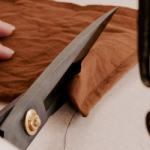What is fashion designing? Fashion designing is the art of creating unique clothing and accessories, blending creativity and aesthetics with functionality. It involves sketching, fabric selection, pattern-making, and garment construction, manifesting individual style and trends. In this blog, we’ll explore the vibrant world of fashion design, encompassing its significance, diverse types, pathways to entry, and the dynamic scope it holds in the current landscape.
In the realm of fashion, design stands as the fulcrum, dictating trends, and reshaping cultures. Understanding its importance extends beyond creating garments—it’s about shaping identities, expressing innovation, and reflecting societal shifts. We’ll delve into various fashion design disciplines and unravel the avenues to embark on this creative journey. From educational routes to burgeoning opportunities, we’ll dissect how to venture into this dynamic field and explore the lucrative prospects it offers in 2023 and beyond.
Table of content
Fashion Design Definition
How to Get into Fashion Design
Importance of Fashion Design
Types of Fashion Design
Average Salary in Fashion Design in India
Top 5 Courses in Fashion Design
Fashion Design Definition
What is fashion designing? Fashion design is the art of creating clothing and accessories that adhere to prevailing styles and trends while expressing individuality and functionality. This process involves various stages, including conceptualization, sketching, fabric selection, pattern creation, and garment construction. It encompasses a wide spectrum of elements, from choosing materials and colors to incorporating textures and embellishments, to craft innovative and wearable designs that resonate with specific target audiences or markets. The discipline requires a profound understanding of fashion history, trends, fabrics, and garment construction techniques to bring creative concepts to life.How to Get into Fashion Design?
Entering the world of fashion design involves several steps to build a successful career:- Education: Pursue a course in fashion design by enrolling in reputable fashion schools or institutions offering degree programs or courses in fashion. These programs cover design principles, garment construction, textiles, pattern-making, and other essential skills.
- Develop Skills: Hone your skills by practicing drawing, sketching, and sewing. Gain hands-on experience with design software, understand fabric properties, and stay updated on industry trends.
- Gain Experience: Seek internships or apprenticeships with fashion houses, designers, or companies to gain practical experience. This exposure offers valuable insights into the industry’s workings and builds your network.
- Create a Portfolio: Develop a portfolio showcasing your design projects, sketches, and completed works. A strong portfolio is essential for securing employment or applying for design positions.
- Networking: Attend industry events, fashion shows, workshops, and exhibitions to network with professionals. Networking helps in making connections, learning from experienced designers, and discovering job opportunities.
- Stay Updated: Fashion is ever-evolving. Stay abreast of the latest trends, technologies, and industry developments. Continuous learning and adaptability are crucial in this field.
- Entry-level Positions: Start with entry-level positions like assistant designer, design assistant, or intern to gain industry experience and work your way up.
- Showcase Creativity: Whether through your portfolio, social media, or personal projects, showcase your unique style and creativity. A distinctive aesthetic can set you apart in the competitive fashion landscape.
- Persistence and Perseverance: Fashion design is a competitive field. Be prepared for rejections, learn from setbacks, and persistently pursue your goals.
Importance of Fashion Design
Fashion design holds immense significance in the world of style and clothing. Its importance extends beyond mere aesthetics and trends, playing a pivotal role in various aspects:- Individual Expression: Fashion design allows individuals to express their identity, personality, and creativity through clothing. It helps in conveying emotions, attitudes, and cultural affiliations.
- Economic Contribution: The fashion industry contributes significantly to the global economy by generating employment opportunities, fostering innovation, and driving commerce.
- Cultural Impact: Fashion design reflects and influences cultural movements, societal changes, and historical narratives. It shapes and is shaped by cultural shifts and societal norms.
- Innovation and Trends: Designers continuously innovate, setting trends and pushing boundaries in terms of style, materials, and design techniques, thereby influencing global fashion trends.
- Functional Aesthetics: Beyond style, fashion design involves creating functional clothing that meets the needs and demands of wearers while ensuring comfort, durability, and practicality.
- Brand Identity: Fashion design forms the core of brand identity for fashion houses, defining their unique style, aesthetic, and market positioning.
Types of Fashion Design
Here’s a detailed breakdown of different types of fashion design:- Haute Couture: Known for its exclusivity and high-quality craftsmanship, haute couture involves creating custom-made, high-fashion garments. These pieces are tailored to fit specific clients and are meticulously crafted using luxurious fabrics, often incorporating intricate detailing and handwork. Haute couture pieces are typically created by renowned designers and fashion houses, showcasing exceptional creativity and skill.
- Luxury Fashion: Luxury fashion emphasizes quality, sophistication, and exclusivity. It encompasses a wide range of high-end brands that cater to a niche market, offering premium-priced clothing, accessories, and lifestyle products. Luxury fashion brands focus on superior craftsmanship, premium materials, and unique designs, targeting affluent consumers who seek prestige and status.
- Ready-to-wear Fashion (Prêt-à-Porter): Ready-to-wear fashion is designed for mass production and immediate purchase. These collections are created based on current trends, ensuring that the designs are ready for purchase and wear without requiring any alterations. Ready-to-wear lines are more accessible to the general public compared to haute couture or luxury fashion, offering style and quality at a more affordable price point.
- Economy Fashion: Also referred to as affordable or budget fashion, this segment focuses on producing inexpensive clothing and accessories for a wider consumer base. Economy fashion brands prioritize cost-efficient production methods and materials to offer trendy, budget-friendly options that cater to the mass market.
- Fast Fashion: Known for its rapid production and quick turnover of trends, fast fashion involves creating inexpensive clothing inspired by runway styles and current fashion trends. Fast fashion brands quickly replicate popular designs, producing large quantities at affordable prices. However, this model often raises concerns regarding ethical and environmental sustainability due to its emphasis on constant production and disposal.
Average Salary in Fashion Design in India
In India, the average salary in fashion design varies based on factors like experience, expertise, location, and the segment of the industry one works in. At entry-level positions, salaries may range from around ₹3 to ₹6 lakhs per annum. Mid-level professionals with a few years of experience might earn between ₹8 to ₹15 lakhs annually. Highly experienced and renowned designers or those in top positions within fashion houses or as creative directors can earn well above ₹20 lakhs per annum, often reaching into multiple crores for established and celebrated designers. These figures can significantly differ depending on the company, geographic location, the scale of the fashion house, and the designer’s reputation and clientele.Top 5 Courses in Fashion Design
While I don’t have real-time access to current course rankings, the AAFT Online’s Diploma in Fashion Design is an excellent choice for aspiring fashion designers. Other noteworthy courses often include:- Diploma in Fashion Design (AAFT Online): Offers comprehensive training in fashion design, covering various aspects of the industry, from sketching and pattern-making to understanding textiles and garment construction.
- Bachelor’s in Fashion Design: A full-fledged undergraduate program that provides a broader understanding of design principles, trends, and business aspects within the fashion industry.
- Master’s in Fashion Design: For those seeking advanced knowledge and specialized skills, a master’s program delves deeper into design theory, innovation, and often involves a thesis or a major project.
- Short-Term Intensive Courses: Some institutes offer short-term courses focusing on specific areas like accessory design, fashion marketing, or sustainable fashion, providing focused expertise.
- Online Courses and Workshops: Various online platforms offer courses and workshops covering diverse aspects of fashion design, providing flexibility and often featuring industry experts as instructors.
Conclusion
Fashion designing isn’t just about creating garments; it’s an art form that intertwines creativity, innovation, and functionality. Aspiring designers breathe life into fabric, transforming ideas into tangible expressions of style. This comprehensive world of fashion designing encompasses diverse specialties, offering a wide canvas for creativity. Exploring the depth and breadth of this field can unlock pathways to manifesting one’s unique fashion identity. Fashion designing, an amalgamation of vision and craftsmanship, remains a canvas where imagination flourishes, trends evolve, and style becomes an art. In this blog, we’ve traversed through the essence of what is fashion designing, unraveling its intricacies and the dynamic opportunities it offers in shaping the future of style.(Visited 3,294 times, 1 visits today)
Popular Search
Top 10 DJ India
Makeup Steps
Advantages of Makeup
Interior Designer Salary
Makeup Artist Course
Benefits Of Photography
Hospital Waste Management
Types of Fashion Designing
Types of Lenses in Photography
How to Become a Radio Jockey
Best Nutrition Courses in India
Importance of Media Management
How To Become a Dietitian in India
Importance of Nutrition in Health
Interior Design History and Origins
Top 10 Famous Interior Designers
Top 10 Music Labels in India
Top 10 Best Animation Studios in India
Top 10 Nutraceutical Companies in India
Top 10 Fashion Designers in the World
How To Write a TV Commercial Script
Top 10 Career Opportunities in Fashion Designing
Advantages and Disadvantages of Animation
























